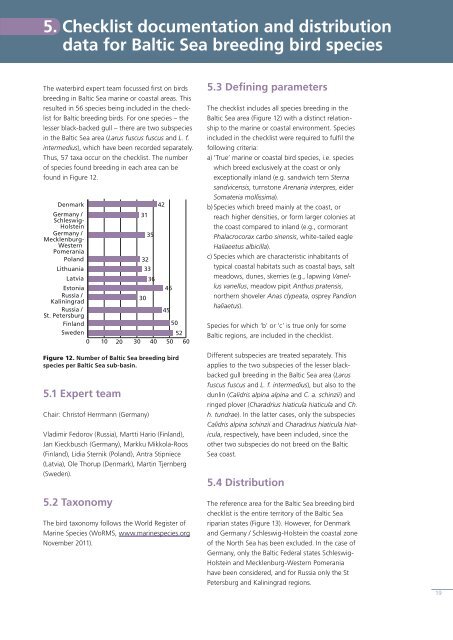Checklist of Baltic Sea Macro-species - IOW
Checklist of Baltic Sea Macro-species - IOW
Checklist of Baltic Sea Macro-species - IOW
You also want an ePaper? Increase the reach of your titles
YUMPU automatically turns print PDFs into web optimized ePapers that Google loves.
5. <strong>Checklist</strong> documentation and distribution<br />
data for <strong>Baltic</strong> <strong>Sea</strong> breeding bird <strong>species</strong><br />
The waterbird expert team focussed first on birds<br />
breeding in <strong>Baltic</strong> <strong>Sea</strong> marine or coastal areas. This<br />
resulted in 56 <strong>species</strong> being included in the checklist<br />
for <strong>Baltic</strong> breeding birds. For one <strong>species</strong> – the<br />
lesser black-backed gull – there are two sub<strong>species</strong><br />
in the <strong>Baltic</strong> <strong>Sea</strong> area (Larus fuscus fuscus and L. f.<br />
intermedius), which have been recorded separately.<br />
Thus, 57 taxa occur on the checklist. The number<br />
<strong>of</strong> <strong>species</strong> found breeding in each area can be<br />
found in Figure 12.<br />
Denmark<br />
Germany /<br />
Schleswig-<br />
Holstein<br />
Germany /<br />
Mecklenburg-<br />
Western<br />
Pomerania<br />
Poland<br />
Lithuania<br />
Latvia<br />
Estonia<br />
46<br />
Russia /<br />
Kaliningrad<br />
30<br />
Russia /<br />
St. Petersburg<br />
45<br />
Finland<br />
50<br />
Sweden<br />
52<br />
0 10 20 30 40 50 60<br />
Figure 12. Number <strong>of</strong> <strong>Baltic</strong> <strong>Sea</strong> breeding bird<br />
<strong>species</strong> per <strong>Baltic</strong> <strong>Sea</strong> sub-basin.<br />
5.1 Expert team<br />
Chair: Christ<strong>of</strong> Herrmann (Germany)<br />
Vladimir Fedorov (Russia), Martti Hario (Finland),<br />
Jan Kieckbusch (Germany), Markku Mikkola-Roos<br />
(Finland), Lidia Sternik (Poland), Antra Stipniece<br />
(Latvia), Ole Thorup (Denmark), Martin Tjernberg<br />
(Sweden).<br />
5.2 Taxonomy<br />
32<br />
33<br />
36<br />
The bird taxonomy follows the World Register <strong>of</strong><br />
Marine Species (WoRMS, www.marine<strong>species</strong>.org<br />
November 2011).<br />
31<br />
35<br />
42<br />
5.3 Defining parameters<br />
The checklist includes all <strong>species</strong> breeding in the<br />
<strong>Baltic</strong> <strong>Sea</strong> area (Figure 12) with a distinct relationship<br />
to the marine or coastal environment. Species<br />
included in the checklist were required to fulfil the<br />
following criteria:<br />
a) ‘True’ marine or coastal bird <strong>species</strong>, i.e. <strong>species</strong><br />
which breed exclusively at the coast or only<br />
exceptionally inland (e.g. sandwich tern Sterna<br />
sandvicensis, turnstone Arenaria interpres, eider<br />
Somateria mollissima).<br />
b) Species which breed mainly at the coast, or<br />
reach higher densities, or form larger colonies at<br />
the coast compared to inland (e.g., cormorant<br />
Phalacrocorax carbo sinensis, white-tailed eagle<br />
Haliaeetus albicilla).<br />
c) Species which are characteristic inhabitants <strong>of</strong><br />
typical coastal habitats such as coastal bays, salt<br />
meadows, dunes, skerries (e.g., lapwing Vanellus<br />
vanellus, meadow pipit Anthus pratensis,<br />
northern shoveler Anas clypeata, osprey Pandion<br />
haliaetus).<br />
Species for which ‘b’ or ‘c’ is true only for some<br />
<strong>Baltic</strong> regions, are included in the checklist.<br />
Different sub<strong>species</strong> are treated separately. This<br />
applies to the two sub<strong>species</strong> <strong>of</strong> the lesser blackbacked<br />
gull breeding in the <strong>Baltic</strong> <strong>Sea</strong> area (Larus<br />
fuscus fuscus and L. f. intermedius), but also to the<br />
dunlin (Calidris alpina alpina and C. a. schinzii) and<br />
ringed plover (Charadrius hiaticula hiaticula and Ch.<br />
h. tundrae). In the latter cases, only the sub<strong>species</strong><br />
Calidris alpina schinzii and Charadrius hiaticula hiaticula,<br />
respectively, have been included, since the<br />
other two sub<strong>species</strong> do not breed on the <strong>Baltic</strong><br />
<strong>Sea</strong> coast.<br />
5.4 Distribution<br />
The reference area for the <strong>Baltic</strong> <strong>Sea</strong> breeding bird<br />
checklist is the entire territory <strong>of</strong> the <strong>Baltic</strong> <strong>Sea</strong><br />
riparian states (Figure 13). However, for Denmark<br />
and Germany / Schleswig-Holstein the coastal zone<br />
<strong>of</strong> the North <strong>Sea</strong> has been excluded. In the case <strong>of</strong><br />
Germany, only the <strong>Baltic</strong> Federal states Schleswig-<br />
Holstein and Mecklenburg-Western Pomerania<br />
have been considered, and for Russia only the St<br />
Petersburg and Kaliningrad regions.<br />
19

















